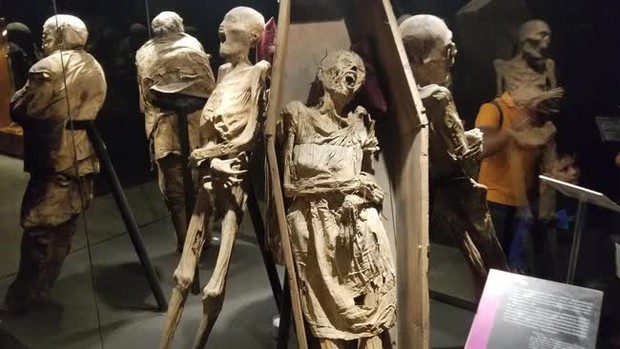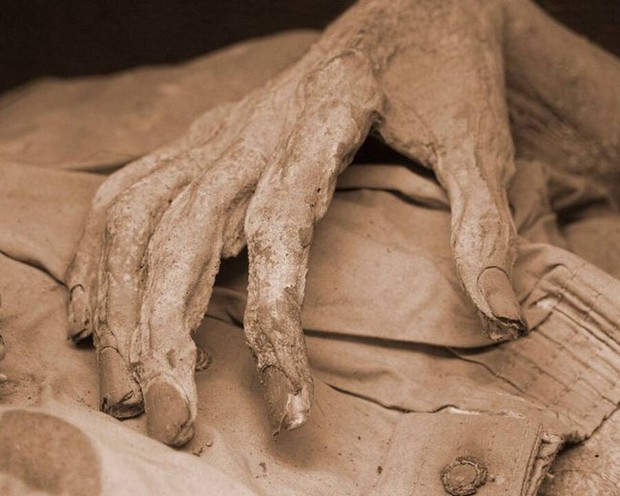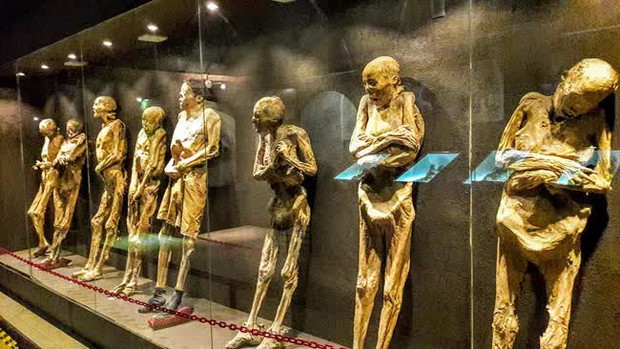One of the Guanajuato mummies showcased at a tourist fair in a Mexican city is believed to exhibit signs of ‘fungus growth’ – and the glass case containing it may not be sufficient to prevent the spread of spores.
The National Institute of Anthropology and History in Mexico has issued a warning that displaying mummies from the 19th century could potentially transmit dangerous fungi to the viewers.
The mummies, often exhibited at the Museo de las Momias (Mummies Museum) in Guanajuato, date back to the 1800s. Subsequently, they were buried in catacombs surrounded by dry, mineral-rich soil, unintentionally turning them into mummies.
Decades later, a new burial tax was imposed, resulting in some families of the deceased being unable to afford the burial. When workers excavated the bodies of those whose descendants didn’t pay, they were shocked to find that nearly all these remains were remarkably well-preserved.
Many mummies still have hair, skin, and even the clothes they were buried in.

The bodies were initially buried during a cholera outbreak in the 1800s. However, they were gradually exhumed from their final resting places between 1865 and 1958 by their surviving relatives who couldn’t, or didn’t want to, pay the taxes to maintain those graves. Photo: Allthatsinteresting
Due to the impressive state of the bodies, the mummies became a “sensation” in the early 1900s. Owners of the mummies would often alter facial expressions to appear awe-stricken and horrified, aiming to attract the “spooky” mummy trend first introduced by Sir Arthur Conan Doyle in the short story “Lot No. 249” in 1892.
The manipulation and display of these mummies sparked criticism from many observers who felt that this treatment was disrespectful and dehumanizing.
Gerald Conlogue, a professor of diagnostic imaging at Quinnipiac University in Connecticut, told National Geographic: “These were just ordinary people, a repository of information about the time they lived. We shouldn’t turn them into freak shows.”
However, reality proved otherwise, as these mummies were taken to various places, featured at tourist fairs across Mexico, and even displayed in the United States in 2009.

Guanajuato’s Mummy Museum in Mexico welcomes over 4,000 visitors each week, charging 2 pounds per person for entry. It is one of the places rated as one of the “creepiest” destinations in the world, preserving hundreds of mummies of victims who succumbed to diseases. Photo: Allthatsinteresting
Now, after viewing recent photos of mummies displayed at a fair in Mexico City, experts at the National Institute of Anthropology and History express concern that these mummies could expose visitors to dangerous fungal spores.
According to the Associated Press report, the Institute stated: “From some published photos, at least one of the displayed mummies that the institute examined in November 2021 shows signs of the proliferation of strange fungi that can occur. What is more worrisome is that they are still displayed without public health protection measures against biological threats.”
At the same time, experts warn that the glass separating the mummies from viewers is not truly safe; it is not airtight, and gaps in the glass could allow dangerous fungal spores to enter the air that visitors breathe.

Behind the transparent glass, one can clearly see the mummies of adults and children of all ages. Many well-preserved corpses, including intact eyebrows, beards, and fingernails, are visible. Photo: Allthatsinteresting
Although experts do not specify the type of fungus growing in the mummies, they warn that they could pose serious health risks.
The incident with the Guanajuato mummies is not the first time preserved corpses have posed health risks to those who come into contact with them. Many believe that the excavation of the tomb of the Egyptian pharaoh Tutankhamun may have also released deadly fungal spores. Over 20 individuals involved in the discovery of his burial place died shortly afterward, fueling rumors of a ‘curse.’

The common feature of many mummies with mouths agape gives the impression that they have experienced excruciating pain. Jesús Saltillo, a tour guide in the museum, shares: ‘In reality, most of them passed away peacefully.’ Instead of being buried in the ground, these deceased individuals were placed in airtight tombs, where the severe lack of oxygen significantly slowed down the natural decomposition process. Photo: Allthatsinteresting
According to IFLScience, the fungus aspergillus could be the culprit behind Tutankhamun’s ‘curse.’ It has the ability to survive for extended periods in dark areas, such as tombs.
In 1970, a similar event occurred when 12 scientists opened the tomb of King Casimir IV of Poland. Within a few weeks, 10 of them died. Researchers are still not certain which type of fungus could be responsible for this event.
However, it is clear that contact with mummies can pose certain dangers.
Source: ATI, Unbelievable, ZME




